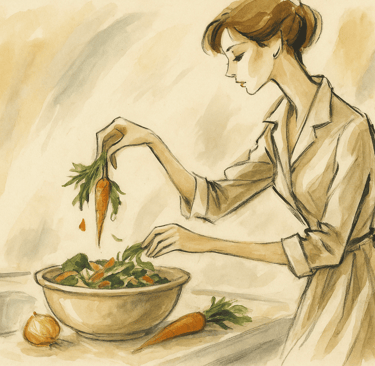The Bowl by the Sink: How to Begin Folk Composting at Home
Before bins, there was a bowl by the sink. Learn how to start folk composting the old way — with scraps, soil, and slow-living intention.
ECO


Before there were bins lined in plastic and trucks with hydraulic arms, there was a bowl on the windowsill and a pile behind the shed.
Waste wasn’t waste. It was part of the cycle.
The peel fed the soil. The core softened in the dark.
And everything you let go of found its way back — quietly, patiently, fruitfully.
At Hida Dream Home, we call this folk composting — not a method, but a memory. Not just recycling, but returning.
What Is Folk Composting?
Folk composting is:
Simple
Seasonal
Local
Intuitive — not scientific
It’s how your bunica, your farm neighbour, or your great-aunt did it:
No gadgets. No ratios. No garden centre supplies.
Just scraps, soil, time, and trust.
The Bowl That Started It All
In every old-world kitchen — Romanian, Swedish, Irish — there was a bowl by the sink.
Into it went:
Potato peels
Onion skins
Tea leaves
Wilted herbs
Apple cores
Bread too dry to save
Crushed eggshells
And when it filled, it didn’t go to the bin.
It went to the earth.
How to Begin Your Own Folk Compost
1. Keep a Bowl on the Windowsill
Choose something old — enamel, ceramic, chipped or beloved.
Let it live beside your sink. Let it fill slowly. Let it become part of your rhythm.
2. Choose a Compost Corner
You don’t need a fancy bin. Try:
A wooden crate
A tucked-away pile under a tree
A pot with a lid by the back step
It doesn’t need perfection. Just consistency.
3. Layer With Love
There’s no measuring, but there is a feel for balance:
Greens – moist scraps, leaves, herbs
Browns – paper, dry grass, straw, twigs
Layer it like a bed. Soft. Nourishing. Even.
What Not to Add
Even the old ways had boundaries:
No meat
No dairy
No glossy paper
No citrus in excess
Because compost isn’t a dump — it’s a living thing. Treat it like something sacred.
Compost Through the Seasons
Spring: Add nettles and wild herbs to heat up the pile
Summer: Let fruit scraps dry slightly to avoid flies
Autumn: Gather leaves for rich, carbon balance
Winter: Cover with hessian or straw — keep it dreaming under frost
The Quiet Magic of Compost
In the old villages, compost wasn’t just practical. It was symbolic.
What’s dead feeds what’s living
What’s bitter breaks down into sweetness
What you return in love, comes back in bloom
There were no tumblers, no accelerators — just time and trust.
What to Tell the Soil
You can whisper it as you empty the bowl:
“This fed me once. May it feed the land next.”
Because folk composting isn’t just about waste.
It’s an offering. A ritual. A return.
Begin Where You Are
No garden? No problem. A balcony bucket. A back doorstep pot. A corner under ivy.
What matters is the mindset — the willingness to return, to let go, to slow down.
Because the soil remembers.
And it’s always waiting.
